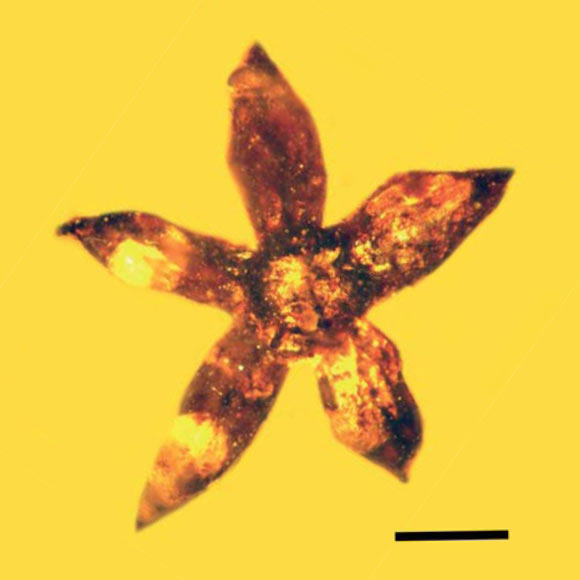Cretaceous Flowers Found Preserved in Burmese Amber
In a paper published recently in the journal Palaeodiversity, U.S. paleontologists described a new species of angiosperm flower, Tropidogyne pentaptera, found in seven pieces of 99-million-year-old (mid-Cretaceous) amber excavated from a mine in Myanmar (also known as Burma).
The amber fossils came from the Noije Bum 2001 Summit Site mine excavated in the Hukawng Valley and located southwest of Maingkhwan in Kachin State.
The flowers range from 3.4 to 5 mm in diameter, necessitating study under a microscope.
“The amber preserved the floral parts so well that they look like they were just picked from the garden,” said Professor George Poinar Jr., of Oregon State University.
“Dinosaurs may have knocked the branches that dropped the flowers into resin deposits on the bark of an araucaria tree, which is thought to have produced the resin that fossilized into the amber.”
“Araucaria trees are related to kauri pines found today in New Zealand and Australia, and kauri pines produce a special resin that resists weathering.”
The new study builds on earlier research also involving Burmese amber in which the same team described another species in the same genus, Tropidogyne pikei.
“Tropidogyne pentaptera has spreading, veiny sepals, a nectar disc, and a ribbed inferior ovary like T. pikei,” Professor Poinar noted.
“But it’s different in that it’s bicarpellate, with two elongated and slender styles, and the ribs of its inferior ovary don’t have darkly pigmented terminal glands like T. pikei.”
Both Tropidogyne pentaptera and T. pikei belong to the extant family Cunoniaceae, a widespread Southern Hemisphere family of 27 genera and about 330 species of woody plants.
“Tropidogyne pentaptera was probably a rainforest tree,” Professor Poinar said.
“In their general shape and venation pattern, the fossil flowers closely resemble those of the genus Ceratopetalum that occur in Australia and Papua-New Guinea,” he added.
“One extant species is Ceratopetalum gummiferum, which is known as the New South Wales Christmas bush because its five sepals turn bright reddish pink close to Christmas.”
“Another extant species in Australia is the coach wood tree (Ceratopetalum apetalum), which like the new species has no petals, only sepals.”
“The towering coach wood tree grows to heights of greater than 120 feet, can live for centuries and produces lumber for flooring, furniture and cabinetwork.”
So what explains the relationship between a mid-Cretaceous Tropidogyne from Myanmar and an extant Ceratopetalum from Australia, more than 4,000 miles and an ocean away to the southeast?
“That’s easy, if you consider the geological history of the regions,” Professor Poinar said.
“Probably the amber site in Myanmar was part of Greater India that separated from the southern hemisphere, the supercontinent Gondwana, and drifted to southern Asia.”
“Malaysia, including Burma, was formed during the Paleozoic and Mesozoic eras by subduction of terranes that successfully separated and then moved northward by continental drift.”
_____
George O. Poinar, Jr. & Kenton L. Chambers. 2017. Tropidogyne pentaptera, sp. nov., a new mid-Cretaceous fossil angiosperm flower in Burmese amber. Palaeodiversity 10 (1): 135-140; doi: 10.18476/pale.v10.a10
Source: www.sci-news.com










